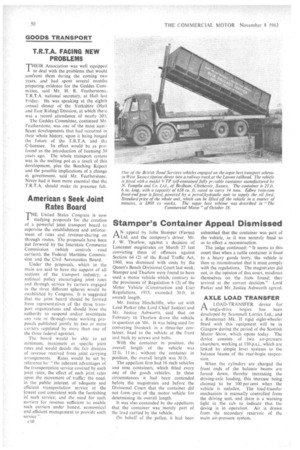Stamper's Container Appeal Dismissed
Page 54

If you've noticed an error in this article please click here to report it so we can fix it.
AN appeal by John Stamper (Farms) Ltd. and the company's driver, Mr. J. W. Thurlow, against a decision of Lancaster magistrates on March 27 last convicting them of offences against Section 64 (2) of the Road Traffic Act, 1960, was dismissed with costs by the Queen's Bench Divisional Court last week. Stamper and Thurlow were found to have used a motor vehicle which, contrary to the provisions of Regulation 6 (3) of the Motor Vehicle (Construction and Use) Regulations. 1955, exceeded 30 ft. in overall length.
Mr. Justice .Flinchcliffe, who sat with Lord Parker (the Lord Chief Justice) and Mr. Justice Ashworth, said that on February 16 Thurlow drove the vehicle in question on M6. It was being used for conveying livestock in a three-tier container, fixed to the vehicle at the front and back by screws and bolts.
With the container in position, the overall length of the vehicle was 32 ft. 11 in.; without the container in position, the overall length was 30 ft.
The appellant firm had 16 such vehicles and nine containers, which fitted every one of the goods vehicles. In these circumstances it had been contended before the magistrates and before the Divisional Court that the container did not form part of the motor vehicle for determining its overall length.
It was also contended by the appellants that the container was merely part of the load carried by the vehicle.
On behalf of the police, it had been submitted that the container was part of the vehicle, as it was securely fixed so as to effect a reconstruction.
The judge continued: "It seems to this court that when a cattle container is fixed to a heavy goods lorry, the vehicle is then so reconstructed that it must comply with the regulations. The magistrates did not, in the opinion of this court, misdirect themselves on the facts found; they arrived at the correct decision." Lord Parker and Mr. Justice Ashworth agreed.














































































































































































































































